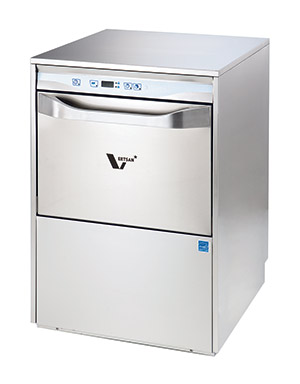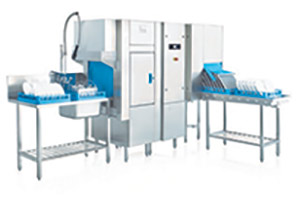Components of these units include removable upper and lower rinse arms, pump drains, detergent pumps, built-in temperature boosters for high-temp warewashers and sanitizing pumps on low-temp machines. Insulated doors, low-chemical alerts and delime alarms typically come standard. Some warewashers have digital controls on top that display water temperature and cycle information, while others can automatically extend the rinse cycle to ensure water reaches 180 degrees F.
Flight-type, also called rackless, warewashers have a setup akin to a car wash. These units are best-suited for large, high-volume operations, such as cafeterias, banquet and catering halls, or prisons. Due to the big footprint, these systems require a great deal of space.
Rack warewashers, commonly referred to as rack conveyors, are often used in full-service restaurants and higher-volume applications, such as universities and healthcare foodservice. This is because the average production rate for these continuous-motion machines is between 100 and 300 racks an hour. While undercounter and door-type machines also use racks, this reference typically is limited to the conveyor-type units.
Despite the number of options available for reducing water costs associated with dishwashing, the drawback remains that there has been little research in terms of total life-cycle costs. “Usage can very day by day,” says Chris Moyer, manager of Conserve.restaurant.org, the National Restaurant Association’s sustainable information resource.
Featured Products
-

VDU30 Undercounter Dishwasher
Veetsan Star
The VDU30 Undercounter Dishwasher is suitable for use in bars and small restaurants. This sanitizing dishwasher cleans up to 30 racks per hour in 180-degree F water. The unit requires a cold water line hookup.
-

KA Series Rack Conveyor Dishwashers
Meiko USA Inc.
The KA Series rack conveyor system features a high-contrast, glass touch-screen display that keeps operators informed during the washing process. Available information includes service diagnostics, error logging, troubleshooting and real-time performance updates.
Related Articles
-
What to Consider When Purchasing a Faucet
Read FeatureFaucets are an obvious necessity in commercial kitchens, and foodservice operators can choose from a variety of types, including units designed for handwashing, prerinsing of dishes and various cleaning jobs.
-
What to Consider When Purchasing a Disposer
Read FeatureNot following manufacturers’ recommendations when selecting a disposer can result in an inadequate system that will not meet the operation’s waste needs. Because most operations become more dependent on these systems than anticipated, it is better to go bigger in terms of horsepower to ensure the waste amount can be accommodated.











